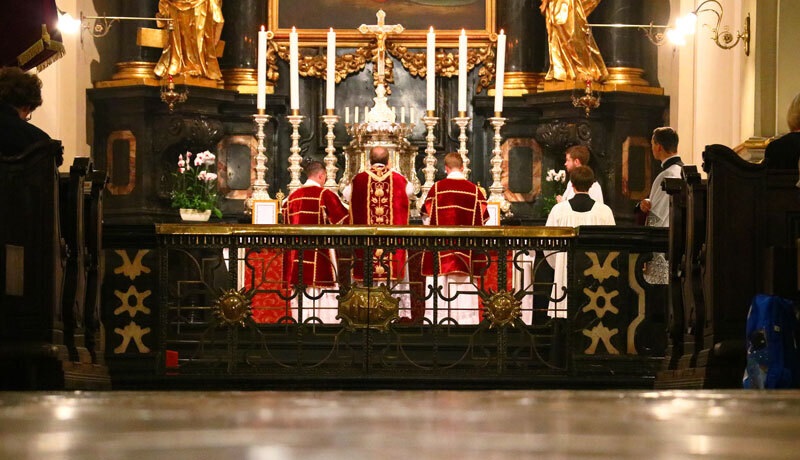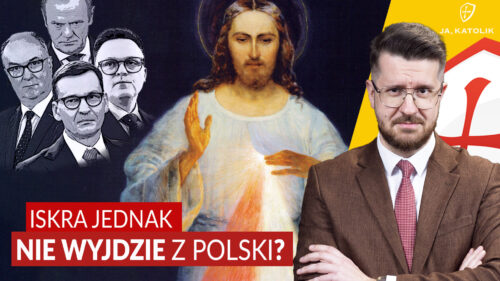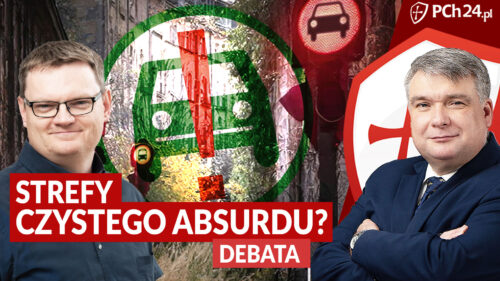Judaism and the Church’s dialogue with its followers often arises extreme emotions. They result from misunderstandings. Let’s say clearly though: the religion of the Old Testament is something different than contemporary Judaism based mainly on the Talmud. The Church doesn’t come from rabbis but from Moses and the prophets. It is Catholicism that is a perfect continuation of the ancient Israelites’ faith.
The beginnings of Judaism go back to the patriarch Abraham. At the beginning of the second millennium B.C. he wandered from Mesopotamia to Kanaan by the Mediterranean Sea. His descendants lived in Egypt though, where pharaohs reduced them to being slaves. Then, in the 13th century B.C. their 40-year-long journey back to Kanaan led by Moses began. It was then that God revealed the Decalogue on the Sinai Mountain to him.
Wesprzyj nas już teraz!
In the 10th century B.C. or so biblical Judaism concentrated around the Temple of Jerusalem holding the Ark of the Covenant was developed. Judaist prophets defended their monistic faith against going down to Paganism. Destruction of the temple and the beginning of the Babylonian captivity in the 6th century B.C. led to the transformation of the religion which was now based mainly on the Law.
In the 4th century B.C. Hellenistic Judaism was developed. Its followers performed their cult in the second rebuilt temple. When Jesus Christ was born some Jews recognised him as Messiah announced by Jewish prophets. Other Jews rejected Him. In the year 70 A.D. the Romans destroyed the second temple in Jerusalem. This was a turning point in the history of Judaism.
What could be done? The Torah experts, rabbis, gathered in the town of Yavne. They agreed on how they should function without a temple. So-called rabbinic Judaism was based on prayers in numerous synagogues rather than in one temple. The Talmud and the rabbis replaced religious animal sacrifice and priesthood. Between the 5th and 7th century Jews wrote the Talmud down. It consists of the Gemara, a rabbinic commentary on Mishnah (oral tradition codified around the year 200 A.D.) and Midrash, commentaries to the Torah.
As Reverend Waldemar Chrostowski pointed out, the centre of rabbinic Judaism is the Talmud and not the Old Testament. The Talmud plays the same role as the New Testament in Christianity. Moreover, as the reverend noted on some other occasion (“How to read the Holy Bible?” – a lecture from the “Spirituality for Warsaw” series, part 1 – 2017/2018 available on youtube.com), reading the Bible is different in the case of Christians and Jews. Christians read it in a Christological way. In the message of the Old Testament they see references to Christ.
Thus, the New Testament complements the Old Testament. The rabbinic exegesis of the Bible leads to a different understanding of Messiah. It stops seeing an individual in Him. On the contrary, many contemporary rabbis consider the whole Israel to be Messiah. In this way Messiah becomes a collective entity.
Contemporary, meaning rabbinic, Jews follow (at least they should!) 613 commandments included in the Talmud. These are ethical and ceremonial indications (prayer three times a day, resting during the Sabbath), guidelines regarding the food (kosher) as well as holidays (Yom Kippur, Rosh Hashanah, Pesach, etc.).
The roots of the Church
The Catholic Church is younger than Judaism. No wonder. After all it comes from it (from biblical and not rabbinic Judaism!). It was founded on the Pentecost day in the 1st century when the Holy Spirit descended upon the Apostles. Soon afterwards, during the so-called Council of Jerusalem, the Apostles released Christians converted from Paganism from the obligation to follow the majority of regulations of the Law. Christianity started to separate itself as a religion different from Judaism. Other councils, such as the Council of Nicaea, when the Holy Trinity dogma was announced, contribute to that. A fundamental, although not indiscriminate, acceptance for the classic civilisation (Greco-Roman) is not without significance.
Similarities and differences
As can be seen, the Church and Judaism has the mutual heritage in common: the Old Testament (the Torah for Jews), monotheism as well as the esteem for Jewish prophets and law-makers. It is Abraham, Moses and the prophets as well as other people who are Catholics’ older brothers in faith. Moreover, since Christ is a Jew as concerning the flesh (Romans 9,5) the attempt to marry Christianity with antisemitism is not only a moral evil but also a logical contradiction. Moreover, as Reverend Waldemar Chrostowski pointed out during the “Opinion Leaders Academy” in 2014 (youtube.com), Catholicism (and Orthodox Church) continues the spirit of the Old Testament religion (priesthood, temple, sacrifice).
Meanwhile, some contemporary theologians, influenced by the so-called post-Auschwitz theology, mistakenly identify biblical Judaism with rabbinic Judaism. If, as they reason, both are “Judaism”, many are misled and consider them one religion. Meanwhile, the opposites are important. We should not underestimate them.
The first difference between Catholicism and rabbinic Judaism is the attitude towards Christ. According to the second religion, Jesus is a common man while the Church teaches that He is God, the second Person in the Holy Trinity. He is also Messiah promised by the prophets of the First Covenant who became human in order to redeem the world. Thus, Jews are still waiting for Messiah to come while the Church believes that it had already happened.
Moreover, while rabbinic Judaism is essentially limited to one nation, Christianity is universalistic. Therefore, any racism and national chauvinism (including antisemitism) argues with Christianism. As Saint Paul wrote: “For as many of you as were baptized into Christ did put on Christ. There can be neither Jew nor Greek, there can be neither bond nor free, there can be no male and female; for you all are one man in Christ Jesus.” (Ga 3;27-28).
Although loyalty to the nation and the country is still valid (the fourth commandment), it is relativized. Love of one’s neighbour applies to everyone. Meanwhile, in rabbinic Judaism, as a state religion, nation remains something essential. It has an impact on ethics. According to Feliks Koneczny there are four ethics in rabbinic Judaism: for Jews and non-Jews in Palestine and for Jews and non-Jews in other parts of the world.
It is connected with a different approach to proselytism. The Church is open to new followers although it sets difficult moral requirements for them. “Go and make disciples of all the nations, baptizing them into the name of the Father and of the Son and of the Holy Spirit.” (Matthew 28,19) – the Christ’s last order says. Converting to Judaism is difficult if not impossible.
Law and morality
Judaism is a religion based less on the faith accepted in one’s heart and more on the Law and following this Law. Some of these laws arise particular controversies among Christians. For example, the prohibition of the name of Jesus to be pronounced by orthodox Jews. However, also other legs of Judaist regulations control almost every sphere of life. It makes differentiating between sacrum and profane difficult. Meanwhile, in the Church the law is limited almost exclusively to the basic moral recommendations. Besides, the majority of them are requirements of natural law and can be discovered by the mind itself (although it is difficult). There is also evangelic advice that goes beyond the law: poverty, chastity, obedience. Judaism doesn’t know them. Celibate remains unknown to its followers.
Although there are fewer laws in the Church, it doesn’t mean that it is a less demanding religion. Quite the opposite. It is demonstrated, for example, by the prohibition of divorces and new relationships. Meanwhile, even biblical Judaism allows divorces (allowed by Moses). There is also polygamy. Also some rabbis prohibited and still prohibit it. However, as Julius H. Greenstone writes in the online Jewish encyclopaedia: “Still, with the majority of Jews (…) the marriage of a married man is considered just as valid as that of an unmarried man”. It is worth noting here that a woman’s position in Judaism is different. At least in religious matters. Essentially, in order to be listened to women need an intermediation of men. They cannot stay next to men in a synagogue. They are even separated at weddings.
Judaism and a conversation
Is it worthwhile talking to Judaism in the light of these differences? For a long time the Church didn’t engage in a dialogue that could suggest equality of two sides. It perceived Jews as witnesses of the trueness of the Bible and somehow Christ because they kept the books of the Old Testament predicting His coming. There were also accusations of Deicide which, according to some people, resulted in antisemitism and pogroms.
Although the Church supported conversion of Jews and certain limitations of their rights, it never gave in to antisemitism motivated by race. However, the Second World War, Shoah and general atmosphere of opening to the world resulted in passing the Nostra Aetate declaration. In this document Fathers of the Second Vatican Council condemned antisemitism and accusing all Jews of Deicide. They also called for a dialogue. It was initiated, among others, by Saint John Paul II. In 1986 he visited a synagogue in Rome. By doing so he earned admiration of some and scandalised others.
There are extreme opinions as far as the assessment of this dialogue is concerned. We should remember, though, that although the majority of Jews accept the 13 principles of faith approved by Maimonides, current rabbinic Judaism is not a monolith. Therefore, it is difficult to praise or condemn it as a whole. It is divided into ultraorthodox, orthodox, conservative and reformed (liberal) legs. These factions have a different approach to Christians, for example. For the “orthodox” the followers of Christ, as those who believe in the Holy Trinity, are simply Pagans – points out Reverend Chrostowski. A Jew converted to Catholicism is no longer considered a Jew. It is difficult to have any dialogue here.
A different approach to Christians is characteristic for the followers of reformed and liberal Judaism. According to Reverend Chrostowski, sometimes they perceive the followers of Christ as popularisers of the Judaism’s message. As a result, they are more open to a dialogue, which should be appreciated. However, also in this case they will lead us astray if those having a dialogue forget about existing differences.
Marcin Jendrzejczak

















